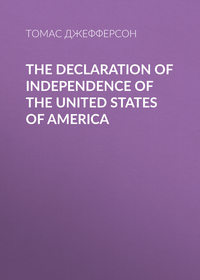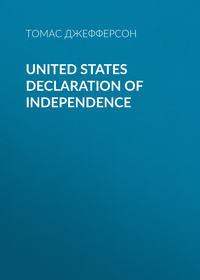 полная версия
полная версияMemoir, Correspondence, And Miscellanies, From The Papers Of Thomas Jefferson, Volume 2
Of Red wines, there are four vineyards of the first quality; viz. 1. Chateau Margau, belonging to the Marquis d’Agincourt, who makes about one hundred and fifty tons, of one thousand bottles each. He has engaged to Jernon, a merchant. 2. La Tour de Segur, en Saint Lambert, belonging to Monsieur Miresmenil, who makes one hundred and twenty-five tons. 3. Hautbrion, belonging two-thirds to M. le Comte de Femelle, who has engaged to Barton, a merchant: the other third to the Comte de Toulouse, at Toulouse. The whole is seventy-five tons. 4. Chateau de la Fite, belonging to the President Pichard, at Bordeaux, who makes one hundred and seventy-five tons. The wines of the three first, are not in perfection till four years old: those of de la Fite, being somewhat lighter, are good at three years; that is, the crop of 1786 is good in the spring of 1789. These growths, of the year 1783, sell now at two thousand livres the ton; those of 1784, on account of the superior quality of that vintage, sell at twenty-four hundred livres; those of 1785, at eighteen hundred livres; those of 1786, at eighteen hundred livres, though they had sold at first for only fifteen hundred livres. Red wines of the second quality, are Rozan, Dabbadie or Lionville, la Rose, Qui-rouen, Durfort; in all eight hundred tons, which sell at one thousand livres, new. The third class, are Galons, Mouton, Gassie, Arboete, Pontette, de Ferme, Candale; in all two thousand tons, at eight or nine hundred livres. After these, they are reckoned common wines, and sell from five hundred livres, down to one hundred and twenty livres, the ton. All red wines decline after a certain age, losing color, flavor, and body. Those of Bordeaux begin to decline at about seven years old.
Of White wines, those made in the canton of Grave, are most esteemed at Bordeaux. The best crops are, 1. Pontac, which formerly belonged to M. de Pontac, but now to M. de Lamont. He makes forty tons, which sell at four hundred livres, new. 2. St. Brise, belonging to M. de Pontac; thirty tons, at three hundred and fifty livres. 3. De Carbonius, belonging to the Benedictine monks, who make fifty tons, and never selling till three or four years old, get eight hundred livres the ton. Those made in the three parishes next above Grave, and more esteemed at Paris, are, 1. Sauterne. The best crop belongs to M. Diquem at Bordeaux, or to M. de Salus, his son-in-law; one hundred and fifty tons, at three hundred livres, new, and six hundred livres, old. The next best crop is M. de Fillotte’s, one hundred tons, sold at the same price. 2. Prignac. The best is the President du Roy’s, at Bordeaux. He makes one hundred and seventy-five tons, which sell at three hundred livres, new, and six hundred livres, old. Those of 1784, for their extraordinary quality, sell at eight hundred livres. 3. Barsac. The best belongs to the President Pichard, who makes one hundred and fifty tons, at two hundred and eighteen livres, new, and six hundred livres, old. Sauterne is the pleasantest; next Prignac, and lastly Barsac: but Barsac is the strongest; next Prignac, and lastly Sauterne; and all stronger than Grave. There are other good crops made in the same parishes of Sauterne, Prignac, and Barsac; but none as good as these. There is a virgin wine, which, though made of a red grape, is of a light rose color, because, being made without pressure, the coloring matter of the skin does not mix with the juice. There are other white wines, from the preceding prices down to seventy-five livres. In general, the white wines keep longest. They will be in perfection till fifteen or twenty years of age. The best vintage now to be bought, is of 1784; both of red and white. There has been no other good year since 1779. The celebrated vineyards before mentioned, are plains, as is generally the canton of Medoc, and that of the Grave. The soil of Hautbrion, particularly, which I examined, is a sand, in which is near as much round gravel or small stone, and very little loam: and this is the general soil of Medoc. That of Pontac, which I examined also, is a little different. It is clayey, with a fourth or fifth of fine rotten stone; and at two feet depth, it becomes all a rotten stone. M. de Lamont tells me, he has a kind of grape without seeds, which I did not formerly suppose to exist; but I saw at Marseilles dried raisins from Smyrna without seeds. I see in his farm at Pontac, some plants of white clover, and a good deal of yellow: also some small peach trees in the open ground. The principal English wine merchants at Bordeaux, are Jernon, Barton, Johnston, Foster, Skinner, Copinger, and M’Cartey: the chief French wine merchants, are Feger, Nerac, Bruneaux Jauge, and Du Verget. Desgrands, a wine-broker, tells me they never mix the wines of first quality: but that they mix the inferior ones to improve them. The smallest wines make the best brandy. They yield about a fifth or sixth.
May 28, 29. From Bordeaux to Blaye, the country near the river is hilly, chiefly in vines, some corn, some pasture: further out, are plains, boggy and waste. The soil, in both cases, clay and grit. Some sheep on the waste. To Etauliers, we have sometimes boggy plains, sometimes waving grounds and sandy, always poor, generally waste, in fern and furze, with some corn however, interspersed. To Mirambeau and St. Genis, it is hilly, poor, and mostly waste. There are some corn and maize however, and better trees than usual. Towards Pons, it becomes a little red, mostly rotten stone. There are vines, corn, and maize, which is up. At Pons we approach the Charente; the country becomes better, a blackish mould mixed with a rotten chalky stone: a great many vines, corn, maize, and farouche. From Lajart to Saintes and Rochefort, the soil is reddish, its foundation a chalky rock, at about a foot depth; in vines, corn, maize, clover, lucerne, and pasture. There are more and better trees than I have seen in all my journey; a great many apple and cherry trees: fine cattle and many sheep.
May 30. From Rochefort to La Rochelle, it is sometimes hilly and red, with a chalky foundation, middling good; in corn, pasture, and some waste: sometimes it is reclaimed marsh, in clover and corn, except the parts accessible to the tide, which are in wild grass. About Rochelle, it is a low plain. Towards Usseau, and halfway to Marans, level highlands, red, mixed with an equal quantity of broken chalk; mostly in vines, some corn, and pasture: then to Marans and halfway to St. Hermine, it is reclaimed marsh, dark, tolerably good, and all in pasture: there we rise to plains a little higher, red, with a chalky foundation, boundless to the eye, and altogether in corn and maize.
May 31. At St. Hermine, the country becomes very hilly, a red clay mixed with chalky stone, generally waste, in furze and broom, with some patches of corn and maize; and so it continues to Chantonay, and St. Fulgent. Through the whole of this road from Bordeaux, are frequent hedge rows, and small patches of forest wood, not good, yet better than I had seen in the preceding part of my journey. Towards Montaigu, the soil mends a little; the cultivated parts in corn and pasture, the uncultivated in broom. It is in very small enclosures of ditch and quickset. On approaching the Loire to Nantes, the country is leveller: the soil from Rochelle to this place may be said to have been sometimes red, but oftener gray, and always on a chalky foundation. The last census, of about 1770, made one hundred and twenty thousand inhabitants at Nantes. They conjecture there are now one hundred and fifty thousand, which equals it to Bordeaux.
June 1,2. The country from Nantes to L’Orient is very hilly and poor, the soil gray; nearly half is waste, in furze and broom, among which is some poor grass. The cultivated parts are in corn, some maize, a good many apple trees; no vines. All is in small enclosures of quick hedge and ditch. There are patches and hedge-rows of forest-wood, not quite deserving the name of timber. The people are mostly in villages; they eat rye-bread, and are ragged. The villages announce a general poverty, as does every other appearance. Women smite on the anvil, and work with the hoe, and cows are yoked to labor. There are great numbers of cattle, insomuch that butter is their staple. Neither asses nor mules: yet it is said that the fine mules I have met with on my journey, are raised in Poictou. There are but few chateaux here. I observe mill-ponds, and hoes with long handles. Have they not, in common with us, derived these from England, of which Bretagne is probably a colony? L’Orient is supposed to contain twenty-five thousand inhabitants. They tell me here, that to make a reasonable profit on potash and pearlash, as bought in America, the former should sell at thirty livres, the latter thirty-six livres, the quintal. Of turpentine they make no use in their vessels. Bayonne furnishes pitch enough; but tar is in demand, and ours sells well. The tower of L’Orient is sixty-five pieds above the level of the sea, one hundred and twenty pieds high, twenty-five pieds in diameter; the stairs four feet radius, and cost thirty thousand livres, besides the materials of the old tower.
June 3, 4, 5. The country and productions from L’Orient to Rennes, and from Rennes to Nantes, are precisely similar to those from Nantes to L’Orient. About Rennes, it is somewhat leveller, perhaps less poor, and almost entirely in pasture. The soil always gray. Some small, separate houses, which seem to be the residence of laborers, or very small farmers; the walls frequently of mud, and the roofs generally covered with slate. Great plantations of walnut, and frequently of pine. Some apple trees and sweet-briar still in bloom, and broom generally so. I have heard no nightingale since the last day of May. There are gates in this country made in such a manner, that the top rail of the gate overshoots backwards the hind post, so as to counterpoise the gate, and prevent its swagging.
Nantes. Vessels of eight feet draught only can come to Nantes. Those which are larger, lie at Painboeuf, ten leagues below Nantes, and five leagues above the mouth of the river. There is a continued navigation from Nantes to Paris, through the Loire, the canal de Briare and the Seine. Carolina rice is preferred to that of Lombardy for the Guinea trade, because it requires less water to boil it.
June 6, 7, 8. Nantes. Ancenis. Angers. Tours. Ascending the Loire from Nantes, the road, as far as Angers, leads over the hills, which are gray, oftener below than above mediocrity, and in corn, pasture, vines, some maize, flax, and hemp. There are no waste lands. About the limits of Bretagne and Anjou, which are between Loriottiere and St. George, the lands change for the better. Here and there, we get views of the plains on the Loire, of some extent, and good appearance, in corn and pasture. After passing Angers, the road is raised out of the reach of inundations, so as at the same time to ward them off from the interior plains. It passes generally along the river side; but sometimes leads through the plains, which, after we pass Angers, become extensive and good, in corn, pasture, some maize, hemp, flax, pease, and beans; many willows, also poplars and walnuts. The flax is near ripe. Sweet-briar in general bloom. Some broom here still, on which the cattle and sheep browse in winter and spring, when they have no other green food; and the hogs eat the blossoms and pods, in spring and summer. This blossom, though disagreeable when smelt in a small quantity, is of delicious fragrance when there is a whole field of it. There are some considerable vineyards in the river plains, just before we reach Les Trois Volets (which is at the one hundred and thirty-sixth milestone), and after that, where the hills on the left come into view, they are mostly in vines. Their soil is clayey and stony, a little reddish, and of southern aspect. The hills on the other side of the river, looking to the north, are not in vines. There is very good wine made on these hills; not equal indeed to the Bordeaux of best quality, but to that of good quality, and like it. It is a great article of exportation from Anjou and Touraine, and probably is sold abroad, under the name of Bordeaux. They are now mowing the first crop of hay. All along both hills of the Loire, is a mass of white stone, not durable, growing black with time, and so soft, that the people cut their houses out of the solid, with all the partitions, chimnies, doors, &c. The hill sides resemble cony burrows, full of inhabitants. The borders of the Loire are almost a continued village. There are many chateaux: many cattle, sheep, and horses; some asses.
Tours is at the one hundred and nineteenth mile-stone. Being desirous of inquiring here into a fact stated by Voltaire, in his Questions Encylopédiques, article Coquilles, relative to the growth of shells unconnected with animal bodies at the Chateau of Monsieur de la Sauvagiere, near Tours, I called on Monsieur Gentil, premier sécrétaire de l’ntendance, to whom the Intendant had written on my behalf, at the request of the Marquis de Chastellux.
I stated to him the fact as advanced by Voltaire, and found he was, of all men, the best to whom I could have addressed myself. He told me he had been in correspondence with Voltaire on that very subject, and was perfectly acquainted with Monsieur de la Sauvagiere, and the Faluniere where the fact is said to have taken place. It is at the Chateau de Grillemont, six leagues from Tours, on the road to Bordeaux, belonging now to Monsieur d’Orcai. He says, that De la Sauvagiere was a man of truth, and might be relied on for whatever facts he stated as of his own observation; but that he was overcharged with imagination, which, in matters of opinion and theory, often led him beyond his facts; that this feature in his character had appeared principally in what he wrote on the antiquities of Touraine; but that as to the fact in question, he believed him. That he himself, indeed, had not watched the same identical shells, as Sauvagiere had done, growing from small to great; but that he had often seen such masses of those shells of all sizes, from a point to a full size, as to carry conviction to his mind that they were in the act of growing; that he had once made a collection of shells for the Emperor’s cabinet, reserving duplicates of them for himself; and that these afforded proofs of the same fact; that he afterwards gave those duplicates to a Monsieur du Verget, a physician of Tours, of great science and candor, who was collecting on a larger scale, and who was perfectly in sentiment with Monsieur de la Sauvagiere, and not only the Faluniere, but many other places about Tours, would convince any unbiassed observer, that shells are a fruit of the earth, spontaneously produced; and he gave me a copy of De la Sauvagiere’s Recueil de Dissertations, presented him by the author, wherein is one Sur la vegetation spontanée des coquilles du Chateau des Places. So far, I repeat from him. What are we to conclude? That we have not materials enough yet, to form any conclusion. The fact stated by Sauvagiere is not against any law of nature, and is therefore possible; but it is so little analogous to her habitual processes, that, if true, it would be extraordinary: that to command our belief, therefore, there should be such a suite of observations, as that their untruth would be more extraordinary than the existence of the fact they affirm. The bark of trees, the skin of fruits and animals, the feathers of birds, receive their growth and nutriment from the internal circulation of a juice through the vessels of the individual they cover. We conclude from analogy, then, that the shells of the testaceous tribe receive also their growth from a like internal circulation. If it be urged, that this does not exclude the possibility of a like shell being produced by the passage of a fluid through the pores of the circumjacent body, whether of earth, stone, or water; I answer, that it is not within the usual economy of nature, to use two processes for one species of production. While I withhold my assent, however, from this hypothesis, I must deny it to every other I have ever seen, by which their authors pretend to account for the origin of shells in high places. Some of these are against the laws of nature, and therefore impossible; and others are built on positions more difficult to assent to, than that of De la Sauvagiere. They all suppose these shells to have covered submarine animals, and have then to answer the question, How came they fifteen thousand feet above the level of the sea? And they answer it, by demanding what cannot be conceded. One, therefore, who had rather have no opinion than a false one, will suppose this question one of those beyond the investigation of human sagacity; or wait till further and fuller observations enable him to decide it.
Chanteloup. I heard a nightingale to-day at Chanteloup. The gardener says it is the male, who alone sings, while the female sits; and that when the young are hatched, he also ceases. In the boudoir at Chanteloup, is an ingenious contrivance to hide the projecting steps of a staircase. Three steps were of necessity to project into the boudoir: they are therefore made triangular steps; and instead of being rested on the floor, as usual, they are made fast at their broad end to the stair door, swinging out and in, with that. When it shuts, it runs them under the other steps; when open it brings them out to their proper place. In the kitchen garden, are three pumps, worked by one horse. The pumps are placed in an equilateral triangle, each side of which is of about thirty-five feet. In the centre is a post, ten or twelve feet high, and one foot in diameter. In the top of this, enters the bent end of a lever, of about twelve or fifteen feet long, with a swingle-tree at the other end. About three feet from the bent end, it receives, on a pin, three horizontal bars of iron, which at their other end lay hold of one corner of a quadrantal crank (like a bell crank) moving in a vertical plane, to the other corner of which is hooked the vertical handle of the pump. The crank turns on its point as a centre, by a pin or pivot passing through it. The horse moving the lever horizontally in a circle, every point of the lever describes a horizontal circle. That which receives the three bars, describes a circle of six feet in diameter. It gives a stroke then of six feet to the handle of each pump, at each revolution.
Blois. Orleans. June 9, 10. At Blois, the road leaves the river, and traverses the hills, which are mostly reddish, sometimes gray, good enough, in vines, corn, saintfoin. From Orleans to the river Juines, at Etampes, it is a continued plain of corn, and saintfoin, tolerably good, sometimes gray, sometimes red. From Etampes to Etrechy, the country is mountainous and rocky, resembling that of Fontainebleau. Quere. If it may not be the same vein?
LETTER LVIII.—TO WILLIAM CARMICHAEL, June 14, 1787
TO WILLIAM CARMICHAEL.
Paris, June 14, 1787.
Dear Sir,
Having got back to Paris three days ago, I resume immediately the correspondence with which you have been pleased to honor me. I wish I could have begun it with more agreeable information than that furnished me by Mr. Grand, that the funds of the United States here are exhausted, and himself considerably in advance; and by the board of treasury at New York, that they have no immediate prospect of furnishing us supplies. We are thus left to shift for ourselves, without previous warning. As soon as they shall replenish Mr. Grand’s hands, I will give you notice, that you may recommence your usual drafts on him; unless the board should provide a separate fund for you, dependant on yourself alone, which I have strongly and repeatedly pressed on them, in order to remove the indecency of suffering your drafts to pass through any intermediate hand for payment.
My letters from America came down to the 24th of April. The disturbances in the Eastern States were entirely settled. I do not learn that the government had made any examples. Mr. Hancock’s health being re-established, the want of which had occasioned him to resign the government of Massachusetts, he has been re-elected to the exclusion of Governor Bowdoin. New York still refuses to pass the impost in any form, and were she to pass it, Pennsylvania will not uncouple it from the supplementary funds. These two States and Virginia, are the only ones, my letters say, which have paid any thing into the Continental treasury, for a twelvemonth past. I send you a copy of a circular letter from Congress to the several States, insisting on their removing all obstructions to the recovery of British debts. This was hurried, that it might be delivered to the Assembly of New York before they rose. It was delivered, but they did nothing in consequence of it. The convention to be assembled at Philadelphia will be an able one. Ten States were known to have appointed delegates. Maryland was about to appoint; Connecticut was doubtful; and Rhode Island had refused. We are sure, however, of eleven States. South Carolina has prohibited the importation of slaves for three years; which is a step towards a perpetual prohibition. Between six and seven hundred thousand acres of land are actually surveyed into townships, and the sales are to begin immediately. They are not to be sold for less than a dollar the acre, in public certificates. I wrote you from Bordeaux on the subject of Colonel Smith. I was sorry I missed him there, for other reasons as well as from a curiosity to know his errand. The Notables have laid the foundation of much good here: you have seen it detailed in the public papers. The Prince of Wales is likely to recover from his illness, which was very threatening. It is feared, that three powers have combined to lift the Prince of Orange out of his difficulties. Have you yet the cipher of which I formerly wrote to you, or any copy of it?
I am, with sincere esteem, Dear Sir, your most obedient and most humble servant,
Th: Jefferson.
LETTER LIX.—TO J. BANNISTER, JUNIOR, June 19, 1787
TO J. BANNISTER, JUNIOR.
Paris, June 19, 1787.
Dear Sir,
I have received your favor of April the 23d, from New York, and am sorry to find you have had a relapse. Time and temperance, however, will cure you; to which add exercise. I hope you have long ago had a happy meeting with your friends, with whom a few hours would be to me an ineffable feast. The face of Europe appears a little turbid, but all will subside. The Empress has endeavored to bully the Turk, who laughed at her, and she is going back. The Emperor’s reformations have occasioned the appearance of insurrection in Flanders, and he, according to character, will probably tread back his steps. A change of system here with respect to the Dutch, is suspected; because the Kings of Prussia and England openly espouse the cause of the Stadtholder, and that of the Patriots is likely to fall. The American acquaintances whom you left here, not being stationary, you will hardly expect news of them. Mrs. Barrett, lately dead, was, I think, known to you. I had a letter from Ledyard lately, dated at St. Petersburg. He had but two shirts, and yet more shirts than shillings. Still he was determined to obtain the palm of being the first circumambulator of the earth. He says, that having no money, they kick him from place to place, and thus he expects to be kicked round the globe. Are you become a great walker? You know I preach up that kind of exercise. Shall I send you a conte-pas? It will cost you a dozen louis, but be a great stimulus to walking, as it will record your steps. I finished my tour a week or ten days ago. I went as far as Turin, Milan, Genoa; and never passed three months and a half more delightfully. I returned through the canal of Languedoc, by Bordeaux, Nantes, L’Orient, and Rennes; then returned to Nantes, and came up the Loire to Orleans. I was alone through the whole, and think one travels more usefully when alone, because he reflects more.
Present me in the most friendly terms to Mrs. Bannister and to your father, and be assured of the sincere esteem of, Dear Sir, your friend and servant,
Th: Jefferson.
LETTER LX.—TO JAMES MADISON, June 20, 17874
TO JAMES MADISON.
Paris, June 20, 1787.
Dear Sir,
I wrote you last on the 30th of January, with a Postscript of February the 5th. Having set out the last day of that month to try the waters of Aix, and been journeying since, till the 10th instant, I have been unable to continue my correspondence with you. In the mean time, I have received your several favors of February the 15th, March the 18th and 19th, and April the 23d. The last arrived here about the 25th of May, while those of March the 18th and 19th, though written, five weeks earlier, arrived three weeks later. I mention this, to show you how uncertain is the conveyance through England.









